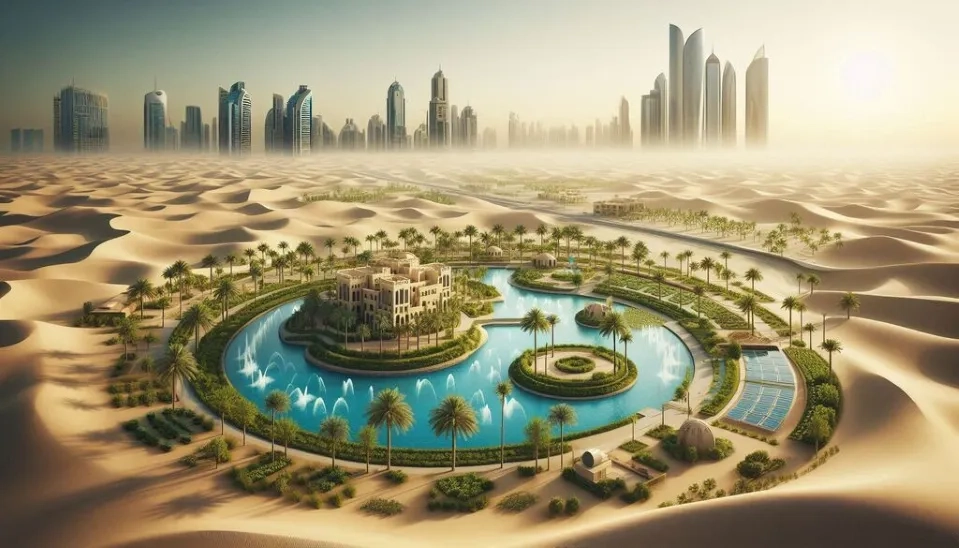
The most advanced and modern urban developments alongside sustainable water conservation practices in one of the hottest and driest cities in the world! A paradox that has become a reality in Abu Dhabi!
The United Arab Emirates (UAE) faces significant water resource challenges due to its arid climate, low and sporadic rainfall, and high evaporation rates. These factors have strained surface and groundwater resources, which are worsened by rapid population growth, economic developments, and inefficient water management practices (Murad et al., 2007). UAE's water issues and management rank among the highest in the world due to heavy groundwater exploitation and extensive desalination efforts to meet rising water demands. However, these practices pose environmental concerns and issues, such as marine pollution and high economic and energy costs (Alsalmi et al., 2013). Abu Dhabi has become a hub for renewable energy and sustainable development initiatives, such as the Masdar Initiative, to diversify energy sources and support sustainable urban growth (Mezher al., 2011). The emirate of Abu Dhabi, the largest emirate of the UAE, by occupying 84% of the UAE-s landmass, home to 3.8 million residents and contributing 68% of the UAE's GDP in 2023, is central to the nation’s water management strategies. The emirate aims to generate 50% of its power from renewable sources by 2030 with projects like the Noor Abu Dhabi solar field and Barakah Nuclear Energy Plant (The Official Portal of the UAE Government). Integrated water resources management and conservation, as well as non-controversial approaches, are crucial to secure water conservation in Abu Dhabi and obtain long-term water sustainability.
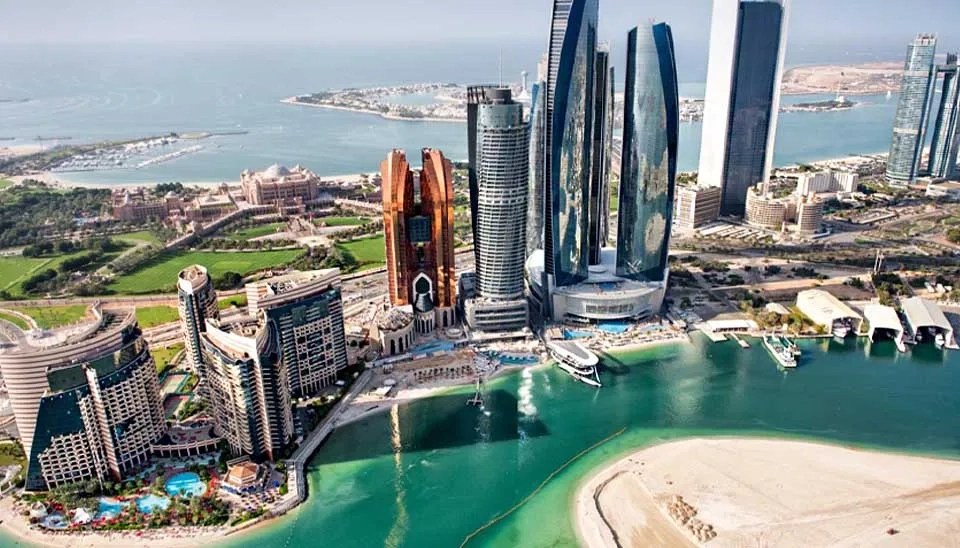
1. Abu Dhabi Water and Electricity Authority
The Abu Dhabi Water and Electricity Authority (ADWEA) is a vital entity in managing Abu Dhabi’s water and electricity needs. ADWEA is the largest producer of water and power in the emirate and primarily operates co-generation plants that simultaneously produce electricity and desalinated water by using technologies such as multi-stage flash (MSF) and multiple-effect distillation (MED). These plans are useful in efficient resource generation. ADWEA owns and operates two unique single-cycle desalination plants in Fujairah that employ reverse osmosis technology. These reverse osmosis plants are the first kind in the UAE and address the challenges of traditional co-generation systems, especially during peak demand periods (Paul et al., 2016).
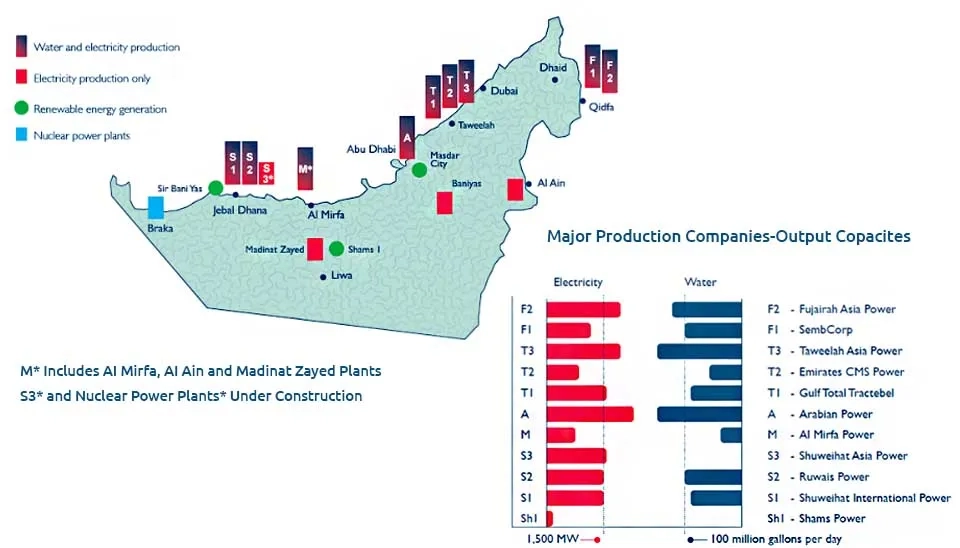
ADWEA also plays a crucial role in Abu Dhabi’s water infrastructure developments such as the construction and operation of desalination plants, water transmission systems, and storage facilities. Its innovative strategies include adopting Integrated Water Resource Management (IWRM), promoting demand-side management through public awareness, and diversifying water sources with treated wastewater and brackish groundwater. ADWEA ensures sustainable and efficient water management through leveraging research and implementing advanced technologies such as smart water systems. Furthermore, ADWEA enhances operational efficiency in Abu Dhabi through the Commercial Directory system, which links suppliers with TAQA's Transmission and Distribution Sector (HLB Abu Dhabi; InsuranceMarket).
2. Masdar City: An Example of Water Conservation in Abu Dhabi
Masdar City is a pioneering sustainable urban community designed in Abu Dhabi to address critical environmental challenges and foster innovative and economic growth. Masdar City is one of the global models for sustainable urban planning by integrating advanced technologies and passive design strategies to reduce its ecological footprint. It employs renewable energy sources like photovoltaic solar panels and geothermal resources, which aligns with Abu Dhabi’s goal of transitioning towards sustainability. Masdar City emphasizes water conservation through passive architectural techniques that minimize cooling demands. Narrow streets are oriented to capture desert winds and reduce temperatures by up to 10 degrees Celsius compared to Abu Dhabi's downtown, consequently limiting the reliance on energy-intensitive air conditioning. (Masdar City).
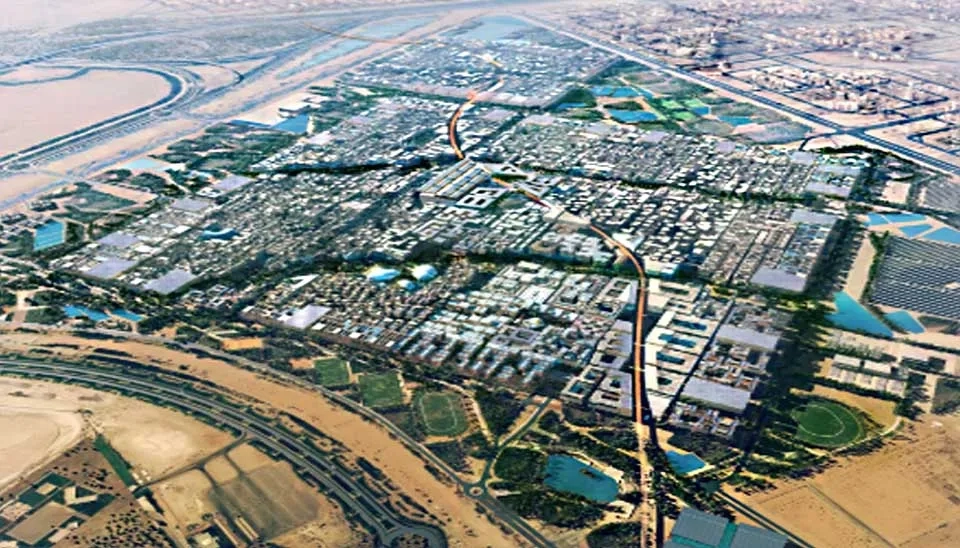
Masdar City achieves remarkable water conservation by using desalinated water processed with solar energy, which makes it suitable for usage such as drinking. Furthermore, Masdar City employs a Membrane Bioreactor (MBR) system to treat and reuse water for irrigation and construction, as well as recycles 100% of its wastewater. Masdar City's daily per capita water consumption is less than half compared to conventional urban areas and plans to achieve a 40% reduction over time (Sankaran and Chopra, 2020; El-Aby, 2017). Masdar City exemplifies the integration of the water-energy-food nexus in a smart urban framework to balance resource demands. Energy and water conservation practices in Masdar City contribute to the UAS’s long-term sustainability by reducing dependence on conventional resources and inspiring global cities to adopt similar practices. (Alzaabi et al., 2018).
3. Water Desalination Plants in Abu Dhabi
Abu Dhabi is a global leader in water desalination for its water security and economic growth. The emirate produces 4.13 million cubic meters of potable water daily with nine major desalination plants and supplies residents and vital sectors through an extensive network spanning over 17700 km. The Abu Dhabi Department of Energy superheads innovation and regulation in water desalination plants and introduces
energy-efficient technologies like reverse osmosis. The major desalination plants in Abu Dhabi include Emirates CMS Power Company (ECPC), Al Shuweihat S1 Plant, Al Shuweihat S2 Plant, Umm Al Nar Plant, Taweelah A2 Plant, Taweelah B Plant, Fujairah F1 Plant, Fujairah F2 Plant, and the Mirfa International Power and Water Company (MIPCO) Plant. Additionally, Abu Dhabi is developing the Al Taweelah Power and Water Complex as the world’s largest desalination plant. After completion, these desalination plants will contribute an additional 909,200 cubic meters of water per day using cost-effective methods (Abu Dhabi Department of Energy).
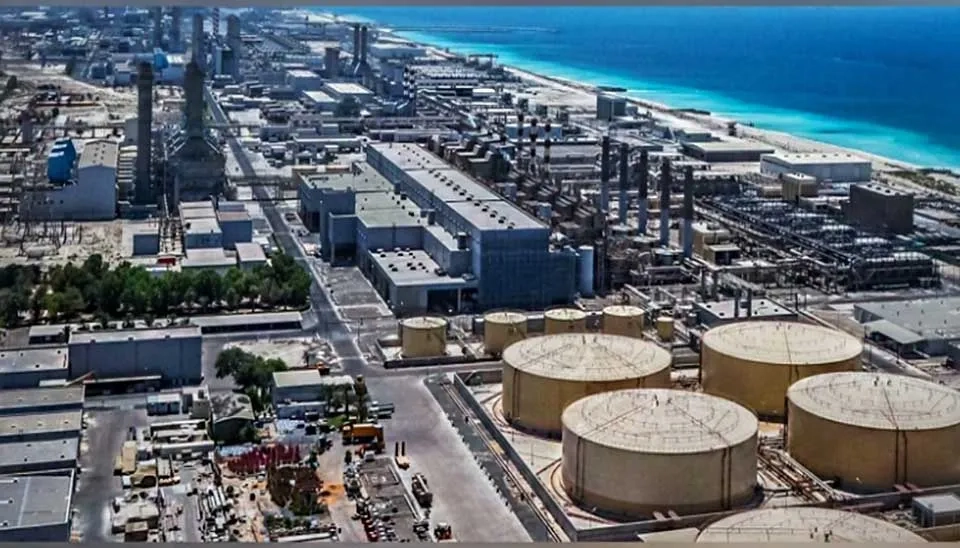
Table 1. Abu Dhabi’s major desalination plants and their daily production capacity
Plant Name | Capacity (Cubic Metres/Day) | Attributes |
Emirates CMS Power Company (ECPC) | 231800 | One of the older plants, licensed in 1999, located in the Taweelah area. |
Al Shuweihat S1 Plant | 459000 | Licensed in 2001; contributes 10.7% of the emirate’s desalination capacity. |
Al Shuweihat S2 Plant | 459000 | Licensed in 2009; provides 11.2% of Abu Dhabi's total water production. |
Umm Al Nar Plant | 432000 | Licensed in 2003; situated on Sas Al Nakl Island. |
Taweelah A2 Plant | 382000 | Licensed in 2000; located northeast of Abu Dhabi City. |
Taweelah B Plant | 736000 | Licensed in 2005; the largest independent power and water plant in the UAE. |
Fujairah F1 Plant | 595500 | Licensed in 2006; located in Fujairah. |
Fujairah F2 Plant | 600000 | Licensed in 2007; uses advanced desalination technologies. |
Mirfa International Power and Water Company (MIPCO) Plant | 241000 | Licensed in 2014; equipped with modern water production facilities. |
Technological advancements underpin Abu Dhabi's desalination sector. 84% of Abu Dhabi's desalinated water is produced through thermal methods such as multi-stage flash and multiple-effect distillation, and reverse osmosis is also gaining attention due to its lower energy requirements. Initiatives like the Masdar Renewable Energy Water Desalination Programme lead to the integration of renewable energy to enhance efficiency significantly. Notable plants include the Shuweihat and Umm Al-Nar stations, which rely on multi-stage flash technology, and the Taweelah A and B plants, which rely on multiple-effect distillation (Abu Dhabi Department of Energy). Multi-stage flash and multiple-effect distillation technologies are discussed in detail below:
3.1. Multi-Stage Flash Distillation
Multi-stage flash distillation is a thermal desalination process that is widely used in the Middle East including UAE and Abu Dhabi for producing freshwater from seawater. Multi-stage flash distillation can be used for large-scale operations such as treating water salinity levels ranging from 5 to 50 ppm. Multi-stage flash distillation involves heating seawater to induce rapid evaporation (flash) in multiple stages followed by condensation to collect fresh water. These systems include several advantages such as minimizing energy costs and carbon emissions as well as high freshwater recovery rates and energy efficiency by using waste heat and renewable energy, which make these systems as greener options among desalination technologies. However, challenges such as scaling, fouling, and corrosion due to organic and inorganic contaminants in seawater can reduce system efficiency and require regular maintenance. Pretreatment techniques such as filtration and chemical dosing, are crucial for mitigating these issues. The transition from small-scale to large-scale multi-stage flash distillation plants requires optimization of parameters like temperature, pressure, and low rates. The design and operation of multi-stage flash systems must consider factors such as the number of stages, heat, transfer efficiency, and seawater ion concentration (Tareemi and Sharshir, 2023). These advancements make multi-stage flash distillation a crucial technology in regions with abundant seawater resources and high freshwater demand, especially UAE and Abu Dhabi.
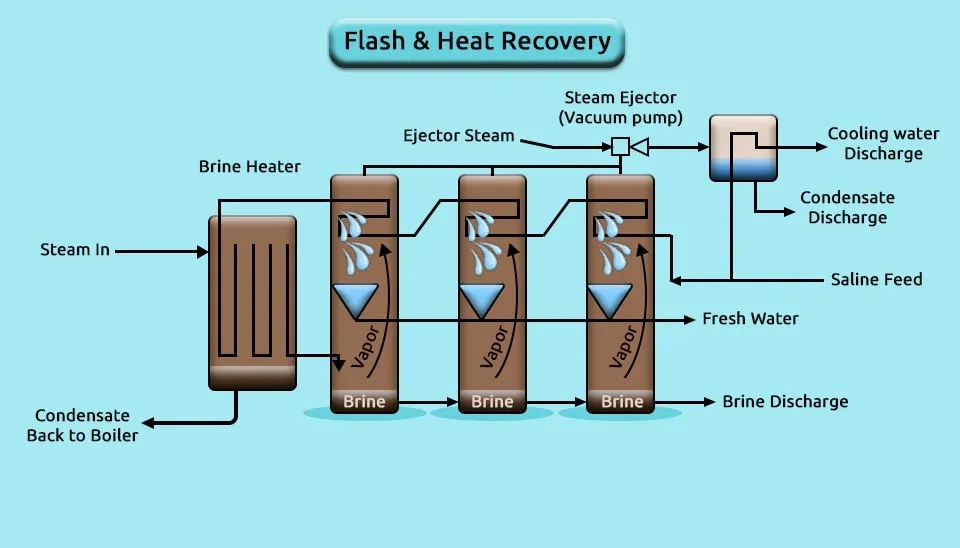
3.2. Multiple-Effect Distillation
Multiple-effect distillation is a thermal desalination process that is effective and energy-efficient for freshwater production from seawater and brackish sources. Multiple-effect distillation operates by sequentially boiling water in a series of effects by using heat from the vapor generated in one effect to drive evaporation in the next. Multiple-effect distillation achieves high heat transfer efficiency and reduces thermal energy consumption compared to multi-stage flash desalination. Multiple-effect distillation can be used for large-scale applications since it has lower operational temperatures and energy demands as well as adaptability to hybrid systems like thermal vapor compression for enhanced performance (Al-Hotmani et al., 2020). Multiple-effect distillation requires lower pumping energy and lower top brine temperature, which minimizes scaling and corrosion issues. It can be integrated with waste heat recovery systems to reduce energy costs and environmental impact. Study in the UAE shows multiple-effect distillation’s economic feasibility when coupled with district cooling systems. Multiple-effect distillation integrated with district cooling demonstrated 25% lower operational costs over a 15-year lifecycle compared to reverse osmosis (Richard Hughes et al., 2013).
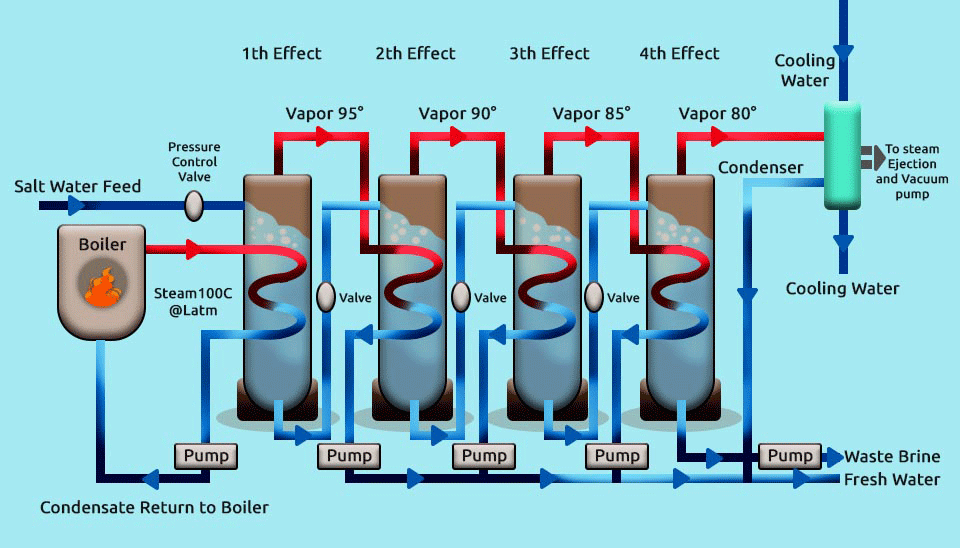
4. Restoration of Abu Dhabi Mangrove Ecosystems
One of the water conservation practices in Abu Dhabi is the restoration of mangrove ecosystems. Mangroves in Abu Dhabi span 176 km² of the UAE's 201 km² total mangrove area and they are vital ecosystems by providing ecological and socio-economic benefits. These habitats are classified as endangered on the Abu Dhabi Red List of Ecosystems due to threats from coastal developments, which result in declines in mangroves over the next two decades. Restoration efforts date back to the early 1970s under the guidance of Sheick Zayad and have expanded to include monitoring, rehabilitation, and conservation programs. Mangrove restoration in Abu Dhabi focuses on degraded areas through measures such as habitat mapping, forest assessments, and long-term monitoring to improve conservation management. Conservation strategies include integrating habitats into urban and rural planning and enforcing protective federal laws. UAE policies prioritize preserving these natural habitats according to the National Environmental Policy and the updated Abu Dhabi Emirate Habitat Classification and Protection Guideline (Environment Agency, Abu Dhabi).
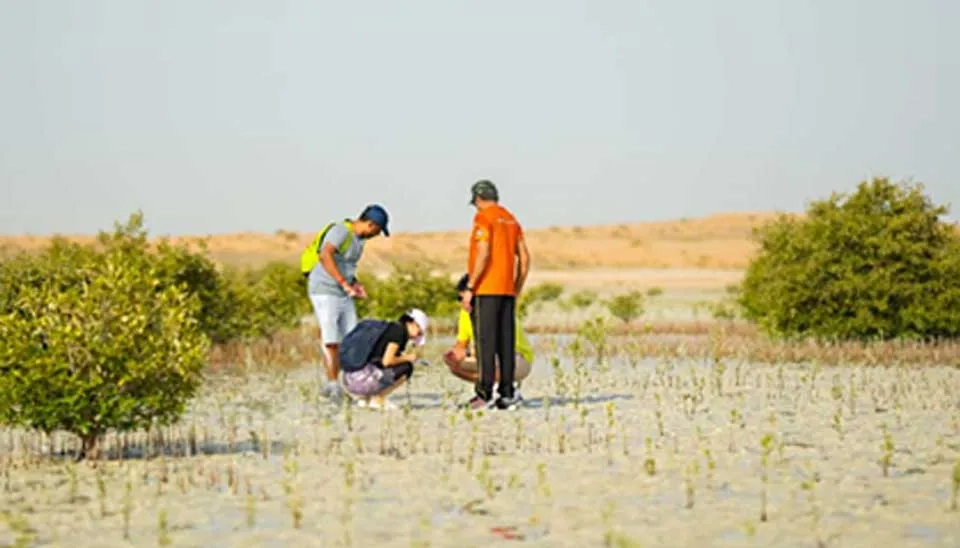

5. Conclusion
Abu Dhabi’s water conservation practices underscore its commitment to sustainable resource management and environmental issues. The UAE and Abu Dhabi have adopted multifaceted approaches, integrated advanced technologies, and sustainable policies to address water scarcity and ecological challenges alongside urban developments. Entities like the Abu Dhabi Water and Electricity Authority lead initiatives in desalination and efficient water management. Modern urban developments like Masdar City showcase innovative water conservation models. Advanced desalination technologies such as multi-stage flash distillation and multiple-effect distillation show Abu Dhabi’s focus and plans on optimizing water production using seawater with minimal environmental impact. Moreover, the restoration of mangrove ecosystems proves Abu Dhabi’s dedication to preserving vital natural habitats and integrating conservation into urban planning. These efforts and practices showcase sustainable strategies to balance urban development with ecological integrity. Consequently, Abu Dhabi not only addresses its current water challenges but also sets a global benc
